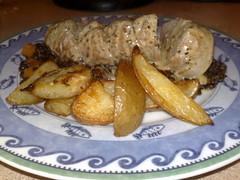Entertaining on a weekend is always easy. And by easy, I mean that, as a rule, I am able to get organised and spend time fiddling about with complicated, multipart recipes. That all makes me extremely happy.
However, there are always occasions where food needs to be put together in a hurry and it’s useful to have a few familiar recipes that I know can be made without too much fuss, too many ingredients, and with very little time.
This is my standard ‘dessert in a hurry’ recipe. Originally, the recipe comes from Gordon Ramsay’s Sunday Lunch*, where it appears as Coffee and Chocolate Mousse Cups. This version is thanks to Almost Bourdain.
The recipe is both egg free and gluten free.
Note that it’s important to beat the mascarpone and icing sugar well. Some mascarpone can be a little grainy (I think this might be a quality thing) and the beating helps reduce this. Also, the (cold) mascarpone and sugar mix is very stiff. I find my (good quality) plastic whisk is not quite up to the job. Of course, using a mixer (such as a KitchenAid) makes this easier but adds significantly to the washing up load …
Also, this is not really a mousse in the way that I think of mousse. It’s more a very dense, but hopefully smooth, chocolate and coffee cream.
Begin by beating 125g of mascarpone with 2 tbsp of icing sugar. Beat well, until the mixture is smooth.
Mix in 4 tbsp of strong espresso coffee and 100g of melted, good quality dark chocolate.
Melting chocolate in a microwave is quicker than on the the stove top but I think it requires a little more attention. Break the chocolate into pieces and microwave (I use med-high because I worry) for just a minute. Stir. Another minute in the microwave. Another stir. That should be just about done …
Finally, whisk 150mL of cream to soft peaks and fold this into the chocolate/coffee/mascarpone mixture. Try to avoid buying ‘thickened cream’. Almost all the cream in my local supermarket appears to have thickening agents of some type in it – you need to look out for something labelled ‘pure cream’. If you’re in the UK, use double cream.
Spoon the mixture into small containers. I’ve used small martini glasses and shot glasses. You could also use espresso cups. It won’t look like a lot but the mixture is dense and rich so no one needs a massive bowl full!
Refrigerate for as long as possible. Overnight is ideal but you can get away with a couple of hours.
Serve with cream or icecream.
See! I said it was easy!



